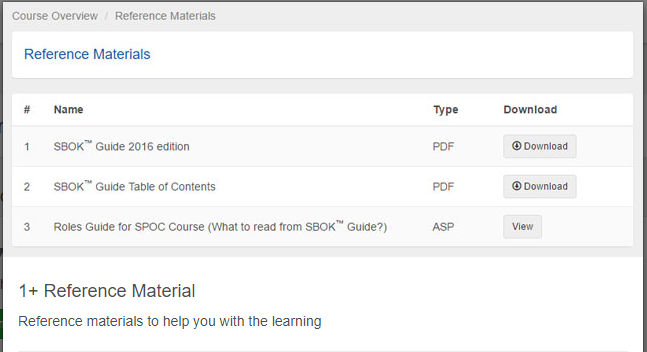SCRUM Master Certification
Learn one of the most popular agile methodologies, Scrum. With Scrum Study, you make project management adaptive, iterative, fast, flexible and deliver significant value quickly to your customers. Scrum ensures your project transparency in communication and creates an environment of collective accountability and continuous progress. Your Scrum Study Certification supports your product and service development in all types of industries and in any type of project, irrespective of its complexity. To purchase this product, simply click on the 'Buy Now' button at the end of the description page. To purchase this product, simply click on the 'BUY NOW' button at the end of the description page. Scroll down to learn more...
- Shipping:
Learn More
About Scrum
Learn one of the most popular agile methodologies, Scrum. With Scrum Study, you make project management adaptive, iterative, fast, flexible and deliver significant value quickly to your customers. Scrum ensures your project transparency in communication and creates an environment of collective accountability and continuous progress. Your Scrum Study Certification supports your product and service development in all types of industries and in any type of project, irrespective of its complexity.
Scrum trains you to use cross-functional, self-organized, and empowered teams to divide work into short, concentrated work cycles called Sprints.
Traditional project management emphasizes conducting detailed upfront planning for the project with a focus on fixing the scope, cost, and schedule - and then managing those parameters. Whereas, Scrum encourages data-based, iterative decision making with the primary focus on delivering products that satisfy customer requirements.
To deliver the greatest amount of value in the shortest amount of time, with Scrum, you prioritize and Time-box task over fixing the scope, cost, and schedule of a project. Scrum features self-organization, which allows team individuals who actually do the work to estimate and take ownership of the tasks.
The Scrum principles provide you the core guidelines for applying the Scrum framework used in all Scrum projects. They are non-negotiable and must be applied as specified in the SBOK™. When you keep the principles intact and apply them appropriately, they instill confidence in the Scrum framework with regard to attaining the objectives of the project.
Each of the below certification courses includes the SBOK Guide. The SBOK™ Guide helps you implement Scrum for project management and needed improvements to your processes. It draws upon from thousands of projects across a variety of organizations and industries. It includes the contributions of many Scrum Study experts and project management practitioners.
Other Features for All Courses
- Fully Accredited by ScrumStudy, Global Accreditation Body for Scrum and Agile Certifications
- PMI PDU units can be used for Project Management recertification units or other fields.
- Includes the digital copy of SBOK Guide
- Includes a mobile phone app for taking and studying the course remotely
- Includes progress checking, which shows where you left off and percent finish for each chapter.
- Personal Metrics for each chapter based on quizzes to show your strength and weaknesses
Scrum Certificates
Scrum Fundamentals Certified (SFC) course helps anyone interested to know more about Scrum; learn about key concepts in Scrum as defined in the SBOK™ Guide; and get a fundamental understanding of how Scrum framework works in delivering successful projects. Passing f the 'Scrum Fundamentals Certified' exam confirms you have basic understanding of the Scrum framework.
Scrum Developer Certified (SDC) is an entry level certification for Scrum Team members and those who interact with any Scrum Team. This certification ensures that Scrum Team members know enough about Scrum to effectively contribute to a Scrum project.
Scrum Master Certified (SMC) professionals are facilitators who ensures and provides the Scrum Team with an environment conducive to completing the project successfully. The Scrum Master guides, facilitates, and teaches Scrum practices to everyone involved in the project. They clear impediments for the team; and, ensures the team follows Scrum Study processes.
Scrum Agile Master Certified (SAMC) appreciate the concepts of Agile development and have the ability to compare and choose the Agile methodology appropriate in a given situation. Rapid changes in technology, market demands, and expectations paved the way for the conceptualization and implementation of Agile methods and values in many organizations. Agile relies on adaptive planning and iterative development and delivery. It focuses primarily on the value of people in getting the job done effectively.
Scrum Product Owner Certified (SPOC) represents the interests of the stakeholder community to the Scrum Team. The Product Owner ensures clear communication of product or service functionality requirements to the Scrum Team, defining Acceptance Criteria, and ensuring those criteria are met. The Product Owner must always maintain a dual view. He or she must understand and support the needs and interests of all stakeholders, while also understanding the needs and workings of the Scrum Team.
Guide to Scrum Body of Knowledge
We include this book with all the above certifications.
The Guide to the Scrum Body of Knowledge (SBOK™ Guide) provides guidelines for the successful implementation of Scrum—the most popular Agile product development and project delivery methodology. Scrum, as defined in the SBOK™ Guide, applies to the following...
- Portfolios, programs, and/or projects in any industry.
- Products, services, or any other results to be delivered to stakeholders.
- Projects of any size or complexity.
The SBOK™ Guide can be used as a reference and knowledge guide by both experienced Scrum study and other product and service development practitioners, as well as by individuals with no prior experience or knowledge of Scrum or other project delivery methodology.
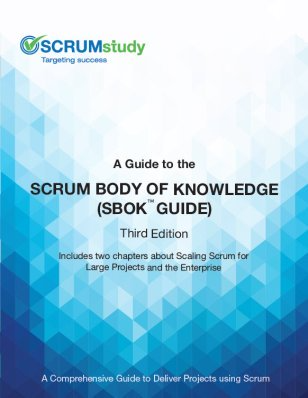
Chapter 1
Describes the purpose and framework of the SBOK™ Guide and provides an introduction to the key concepts of Scrum. It contains a summary of Scrum principles, Scrum aspects and Scrum processes.
Chapter 2
Expands on the six Scrum study principles which forms the foundation for the Scrum framework.
Chapters 3 through 7
Elaborates on the five Scrum study aspects that must be addressed throughout any project: organization, business justification, quality, change, and risk.
Chapters 8 through 12
Covers the 19 Scrum study processes involved in carrying out a Scrum project. These processes are part of the 5 Scrum phases: Initiate; Plan and Estimate; Implement; Review and Retrospect; and Release. These phases describe in detail the associated inputs and outputs of each process, as well as the various tools that may be used in each.
Scrum Study Increases ROI
One of the key characteristics of any project is the uncertainty of results or outcomes. The team cannot guarantee project success at completion, irrespective of the size or complexity of a project. Considering this uncertainty of achieving success, the team needs to start delivering results as early in the project as possible. This early delivery of results, and thereby value, provides an opportunity for reinvestment and proves the worth of the project to interested stakeholders. It is important to:
- Understand what adds value to customers and users and to prioritize these high-value requirements.
- Decrease uncertainty and constantly address risks that can potentially decrease value if they materialize. Also work closely with project stakeholders showing them product increments at the end of each Sprint, enabling effective management of changes.
- Create deliverables based on the priorities determined by producing potentially shippable product increments during each Sprint so the customers realize value early in in the project.
In Scrum study projects, the team ranks User Stories in order of priority. This effective method determines the desired User Stories for each iteration or release of the product or service. The team creates a simple, single list with the goal of prioritizing features, rather than being distracted by multiple prioritization schemes.
This simple list also provides a basis for incorporating changes and identified risks when necessary. Each change or identified risk can be inserted in the list based on its priority relative to the other User Stories in the list. Typically, new changes will be included at the expense of features that have been assigned a lower priority.
The team also defines the Minimum Marketable Features (MMF), so that the first release or iteration happens as early as possible, leading to increased ROI.
Scrum vs. Traditional Project Management
The following table summarizes many of the differences between Scrum and traditional project management:
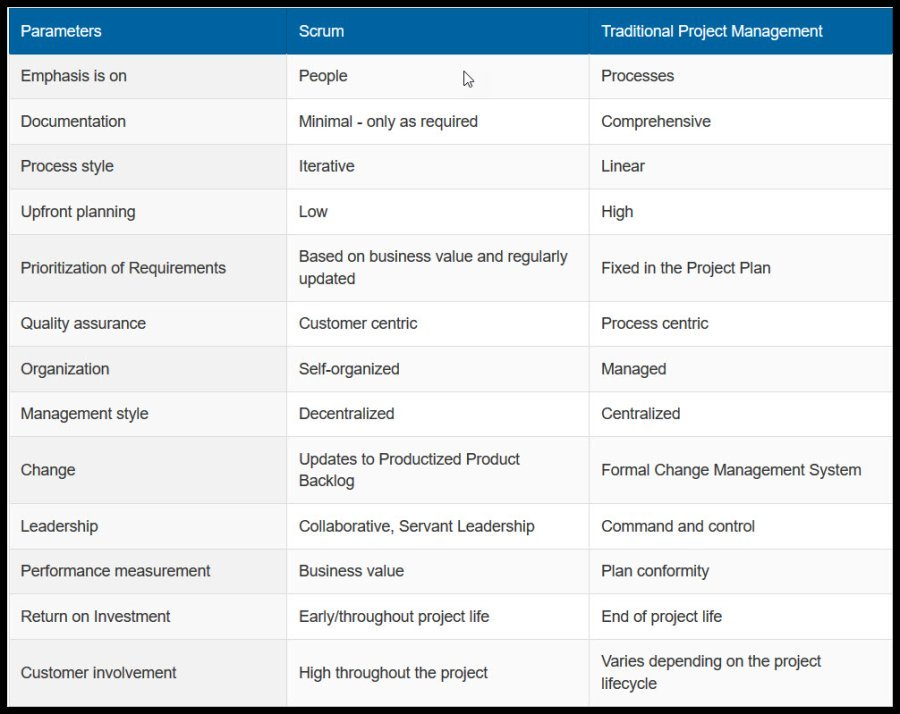
ScrumStudy Vs. Other Certification Bodies
There are three organizations that issue Scrum certifications, and each certifies / qualifies instructors to prepare candidates for their particular certification exams. They are Scrum.org, Scrum Alliance, and SCRUMStudy.
Each has its own designation for approved instructors / trainers. For example, CST is the designation from Scrum Alliance. All three organizations base their exams on the same basic Scrum principles and concepts, and thus are all comparable, and show that those holding the certifications (Scrum Master, Product Owner, etc.) have met basically the same requirements for knowledge and competency relative to Scrum.
Certifications from all three organizations are valid. They are all generally accepted as validating the knowledge and understanding of Scrum principles at a certain level.
ScrumStudy goes further than the others in providing students with information and reference materials that guide in the actual implementation of Scrum. The other two Scrum certification programs miss this.
Scrum study practitioners tend to have a lot of difficulty finding any real standardized information / reference materials on HOW to implement Scrum in organizations. Sure, knowing the terms, concepts, etc. and understanding the key Scrum study principles are great, but you need to know HOW to make this work in projects, where to start, what areas you should focus on, etc.
In asking those aligned with either Scrum.org or Scrum Alliance for more reference materials, you would be directed to a very small book (about 20 pages or so), which they seem to believe tells you everything you need to know to be able to fully implement Scrum. Based on our experience most people don’t find it all that useful.
In addition, we provide significant information on three key subjects that the others don’t to any real degree.
Scrum can be used in areas / projects other than just technology (historically, the focus has been in the technology arena)
Scrum can be implemented in very large-scale projects and initiatives, and we provide some formalized guidance and frameworks on how to accomplish this.
We provide a free on-line course that includes high-quality videos, an illustrative case study, phone apps and a free download of A Guide to the Scrum Body of Knowledge (SBOK™ Guide) with each certification voucher which complements your learning in a class.
Course Features
Certificate PMI Approved PDUs
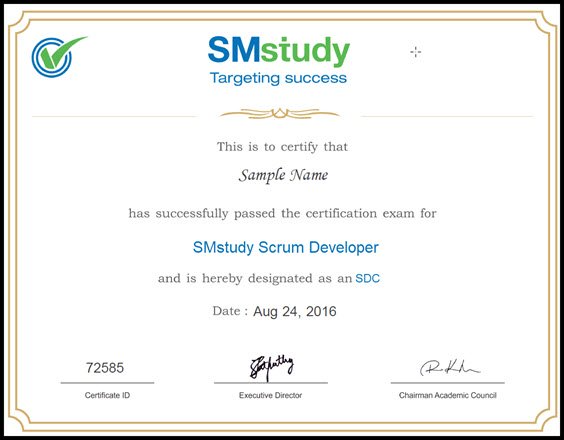
Continuous Improvement Feedback
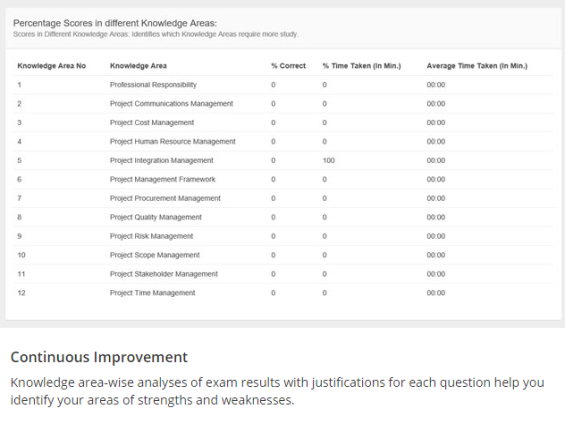
Collaboration Tools

High Quality Videos
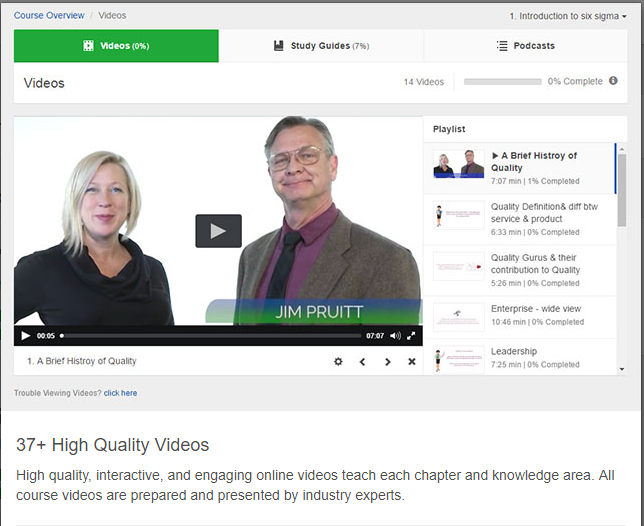
Mobile App

Progress Tracking

SBOK Training Study Guides
